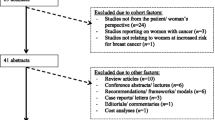Abstract
Tamoxifen reduces primary breast cancer incidence, yet causes serious side effects. To date, few women with increased breast cancer risk have elected to use tamoxifen for chemoprevention. The objective of the study was to determine women’s knowledge of and attitudes toward tamoxifen following exposure to a tailored decision aid (DA). A total of 632 women with a 5-year risk of breast cancer ≥1.66% (Mean = 2.56, range = 1.7–17.3) were recruited from two healthcare organizations. Participants viewed an online DA that informed them about their 5-year risk of breast cancer and presented individually tailored content depicting the risks/benefits of tamoxifen prophylaxis. Outcome measures included behavioral intentions (to seek additional information about tamoxifen, to talk to a physician about tamoxifen, and to take tamoxifen); knowledge; and perceived risks and benefits of tamoxifen. After viewing the DA, 29% of participants said they intended to seek more information or talk to their doctor about tamoxifen, and only 6% believed they would take tamoxifen. Knowledge was considerable, with 63% of women answering at least 5 of 6 knowledge questions correctly. Participants were concerned about the risks of tamoxifen, and many believed that the benefits of tamoxifen did not outweigh the risks. This study is the largest to date to test women’s preferences for taking tamoxifen and one of the largest to have tested the impact of a tailored DA. After viewing the DA, women demonstrated good understanding of tamoxifen’s risks and benefits, but most were not interested in taking tamoxifen for breast cancer chemoprevention.



Similar content being viewed by others
References
Freedman AN, Graubard BI, Rao SR, McCaskill-Stevens W, Ballard-Barbash R, Gail MH (2003) Estimates of the number of U.S. women who could benefit from tamoxifen for breast cancer chemoprevention. J Natl Cancer Inst 95(7):526–532
Rush Port E, Montgomery LL, Heerdt AS, Borgen PI (2001) Patient reluctance toward tamoxifen use for breast cancer primary prevention. Ann Surg Oncol 8(7):580–585
Stacey D, O’Connor AM, De Grasse C, Verma S (2003) Development and evaluation of a breast cancer prevention decision aid for higher-risk women. Health Expect 6:3–18
Melnikow J, Paterniti D, Azari R et al. (2005) Preferences of women evaluating risks of tamoxifen (POWER) study of preferences for tamoxifen for breast cancer risk reduction. Cancer 103(10):1996–2005
Bober SL, Hoke LA, Duda RB, Regan MM, Tung NM (2004) Decision-making about tamoxifen in women at high risk for breast cancer: clinical and psychological factors. J Clin Oncol 22(24):4951–4957
Salant T, Ganschow PS, Olopade OI, Lauderdale DS (2006) “Why take it if you don’t have anything?” Breast cancer risk perceptions and prevention choices at a public hospital. J Gen Intern Med 21:779–785
Metcalfe KA, Snyder C, Seidel J, Hanna D, Lynch HT, Narod S (2005) The use of preventative measures among healthy women who carry BRCA1 or BRCA2 mutation. Familial Cancer 4:97–103
Gail MH, Brinton LA, Byar DP et al (1989) Projecting individualized probabilities of developing breast cancer for white females who are being examined annually. J Natl Cancer Inst 81(24):1879–1886
Fisher B, Costantino JP, Wickerham DL et al (1998) Tamoxifen for prevention of breast cancer: report of the National Surgical Adjuvant Breast and Bowel Project P-1 Study. J Natl Cancer Inst 90(18):1371–1388
Zikmund-Fisher BJ, Ubel PA, Smith DM et al (2008) Communicating side effect risks in a tamoxifen prophylaxis decision aid: the debiasing influence of pictographs. Patient Educ Couns 73(2):209–214
Vogel VG, Costantino JP, Wickerham DL et al (2006) Effects of tamoxifen vs. raloxifene on the risk of developing invasive breast cancer and other disease outcomes. J Am Med Assoc 295(23):2727–2741
Wennberg JE (2002) Promoting Disease Management in Medicare. Testimony before the Subcommittee on Health of the House Committee on Ways and Means, vol 2002
Couper M, Miller P (2008) Web survey methods. Public Opin Q 72(5):831–835
O’Connor AM, Rostom A, Fiset V et al (1999) Decision aids for patients facing health treatment or screening decisions: systematic review. Br Med J 319(7212):731–734
Acknowledgments
We thank Drs Victor Strecher, Priti Shah, and Mick Couper for their assistance with study design. The Center for Heath Communication Research (especially Michael Nowak) did an excellent job turning our DA into a well-designed and easily navigated web site. We also thank Roy Pardee and Rick Krajenta for their assistance with compiling the databases of eligible participants. We express our gratitude to the Department of Radiology at Henry Ford Health System, particularly Dr. Matthew Burke, for their help in identifying eligible patients. Finally, we are very grateful to all the women who participated in this study. Financial support for this study was provided by a grant from the National Institutes for Health (P50 CA101451). Drs. Fagerlin and Smith were supported by MREP early career awards from the U.S. Department of Veterans Affairs. Dr. Zikmund-Fisher is supported by a career development award from the American Cancer Society. The funding agreements insured the authors’ independence in designing the study, interpreting the data, and publishing the report.
Author information
Authors and Affiliations
Corresponding author
Rights and permissions
About this article
Cite this article
Fagerlin, A., Zikmund-Fisher, B.J., Smith, D.M. et al. Women’s decisions regarding tamoxifen for breast cancer prevention: responses to a tailored decision aid. Breast Cancer Res Treat 119, 613–620 (2010). https://doi.org/10.1007/s10549-009-0618-4
Received:
Accepted:
Published:
Issue Date:
DOI: https://doi.org/10.1007/s10549-009-0618-4




